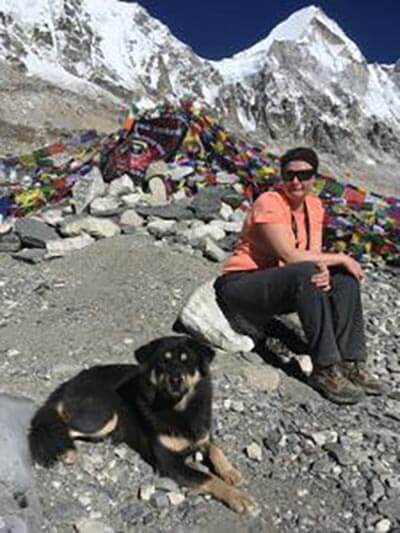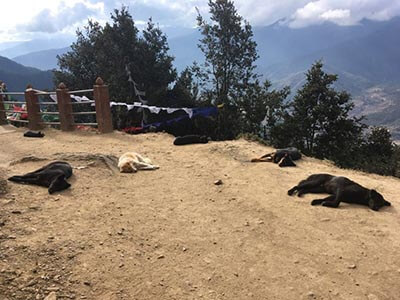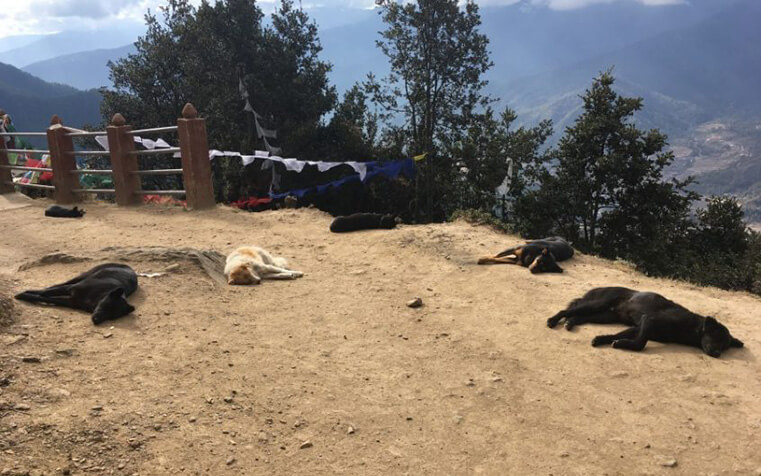As a lover of dogs, I get great joy out of interacting with them, even ones I don’t know. When we travel, I always take note of the dogs, the different breeds and their lifestyles. It’s always different. So recently when I recently travelled to Nepal and Bhutan I became fascinated by the dogs of the Himalayas.
Back home, I have to confess I am guilty of speaking to a dog when I am out walking before I even register that they are attached to a lead and therefore another human (no offence people). I think this is because they genuinely greet us with their big smiles and wagging bodies. Not sure I have been greeted by a human like that lately.
I just love the way dogs live in the present. Unconditional joy, love and man how human they can be? Their mostly silent faces speak a thousand expressions. They know when we are hurting and offer a paw or a nudge or their muzzle gently resting on us to comfort and support. They usually hide when they have done something wrong or casually leave the room after passing wind.
At home in our family we consider our pets especially our dogs, much loved members of our family – referred to as fur-babies or fur-children – some have Instagram and Facebook accounts. I’m the first to admit that I “Follow” and am “Facebook Friends” with a few.
Some would even go as far as to say dogs are better than people (oops sorry did I say that out loud?) I can remember a Fauves song from the 90’s telling me even back then that Dogs are the Best People. It’s hard not to agree with that.
Our latest Census in Australia neglected to include our furry friends on the forms and some of us were outraged that our darlings, our cutie pies, our schnoogy boogies, our wiggle butts were not counted. This was mentioned in mainstream media. Outrage.
There is even a “pet economy” in many countries where dogs and pets have their own version of K-mart, doggy day care, hairdressers (think groomers) and more. Their role as domestic pet has shifted from the bitzer that stayed out in the backyard, to designer breeds holding a place at the table and I’ve really noticed this change over the last 30 years.
But then I arrived in the Himalayas and saw another side of the dog world that completely spun my mind. Dogs were everywhere. And free. No yards, fences or leashes. We saw dogs asleep in gutters right next to 4 lanes of passing traffic, asleep on shopfront steps, asleep in the middle of footpaths while human feet stepped right next to them. They didn’t fear passing cars, scooters, walkers, anything.
For the first half an hour of driving through Kathmandu, I realised that they weren’t “walking with people”. I instantly thought they can’t all be strays because they appeared to be healthy and well-fed. They obviously had territories with imaginary boundaries that we couldn’t see because if they bumped into another equally territorial dog from the next patch they got a warning bark or snarl and if the wandering dog didn’t move on, the dog who owned that patch might have even got a posse of mates involved to help ward off the invader. A secret canine society existed with intricate hierarchies and pecking orders.
But because they appeared in good nick, I still wondered who fed them, who looked after them, who took them to the vet and protected them if they had storm phobias or cared for them when they got sick, needed cuddles etc. It was difficult to process. I had definitely been to other countries where this was not the case the dogs were poorly treated by their human counterparts.
The dogs walked with an air of confidence, no sign of cowering from humans (phew) though many of the females looked as though they had provided many litres of puppies over the years. Some did look like they needed a bath and some TLC, which tested me (I just wanted to adopt them all on the spot!) but then we would drive past the butcher shop and see the dogs lined up patiently waiting for the chance of a scrap or a bone. No-one shooed them away.
In Kathmandu, we did see dogs on leads and dogs belonging to a home/family but most were “street dogs” that knew the traffic and didn’t flinch crossing the road, that slept on roundabouts or lived in monasteries where the monks were guaranteed to feed them.
In the kingdom of Bhutan dogs are considered the closest rebirth to a human through reincarnation. Dogs here are protected somewhat but we did still see a road fatality. I was told not to look but I couldn’t help it. I let a few silent tears fall as we passed the victim of a hit and run.
The breeding of dogs in some of the bigger cities and towns in Bhutan is slowing as the Bhutanese government has a day devoted to vet care. The Bhutanese are asked to take one dog per person to the vet for injections and sterilisation for the equivalent of $1USD. Those sterilised dogs have a tip cut off their ear and we did see quite a few of these.
Sleep by day, bark by night. Thimpbu in Bhutan was a canine chorus after night fall. It was also unsafe to wander at night for tourists because dogs will attack the unfamiliar person walking through their territories. Unless you are a local and the dog knows you/your scent, it’s best to stay indoors after dark. In Kathmandu we found eight dogs very interested in our activities on just a three minute walk to our hotel – we were surrounded fast and luckily for us, they were just friendly.


One of the funniest moments we had was our one and only picnic – in Bhutan. Dogs see this as an invitation to have lunch with you and before we knew it we had 5 to 6 dogs sitting before us with their heads turned sideways, eyes pleading and a gentle snout bumping us in anticipation for a piece of what we were eating. If they hear wrappers in advance, it’s like a call of the wild.
While out trekking in Nepal, we enjoyed having a canine guide or two even at Base Camp! We shared achieving this point in our trek with a canine friend and with Buddhism in the forefront of my mind that day, it was hard not to think the spirits of dogs were mountaineers who have perished and were reborn to look out for those trekking.
At the end of the day, we were simply seeing dogs perhaps as they once were – noble hunters before they saw we had couches. Self-sufficient, taking their liberties and surviving. Puppies in the Himalayas grow up knowing only this and become streetwise – fast. Puppies back home grow up only knowing couches, soft beds, squeaky toys, regular meals and walking on a lead.
Travel teaches us that life is simply not the same as we think for everyone and everything in our world. Dogs are dogs and people are people yet we all exist differently depending on where we are born and raised. I saw a side of dog life that was new to me – maybe how it used to be?
This is why I love to travel. It teaches so much.
And you know what they say about old dogs……
Additional Reading
For more information on our women’s walking group ‘Wise Women Walking’ visit our website here.
To see all our South Australian walking tours, visit our website here.
You can check out all our other walking tours here.
To learn more about ‘Big Heart Adventures’ and wellness walking, visit our website here.

